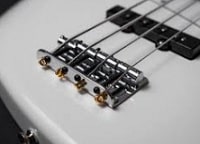 The notion of bridge has more than a dozen meanings in the dictionary of the Royal Spanish Academy ( RAE ). In the field of music , the term can be used to refer to a piece of certain instruments or a part of a song .
The notion of bridge has more than a dozen meanings in the dictionary of the Royal Spanish Academy ( RAE ). In the field of music , the term can be used to refer to a piece of certain instruments or a part of a song .
A bridge is a type of board that is installed perpendicularly on the top of a bowed instrument in order to ensure that the strings are raised . The element located in the lower sector of the top of a string instrument to precisely hold the strings is also called a bridge.
By supporting the strings , the bridge allows vibration to be transmitted to other components. The musical bridge , in this way, provides efficiency to the transfer of sound through the air.
The bridge of a song , on the other hand, is the fragment that is generally located in the middle of the song . Also called an interlude , this is a segment that can have lyrics or be instrumental.
Thanks to the bridge it is possible to avoid monotony in terms of musical characteristics. It can also be used to generate different effects linked to the lyric .
What the musical bridge does, in short, is connect two sections of a song . Many times it is used for the theme to reach its climax , giving way to the final development.
In rock , to mention an example, the bridge usually appears after the second verse. After the bridge, the chorus often returns, which is repeated until the closing.
The composition of the musical bridge is not easy. First of all, we must avoid falling into a predictable melody or lyrics: unfortunately, it is very common for the idea expressed in this part of popular songs to be not relevant at all, but rather to act as "as I was telling you." , to finally resume the chorus.
 A bridge of this nature is a real waste of energy and time, both for the composer and the listener, and can ruin the song in the worst case scenario. The most curious thing is that one of the functions of this musical part is to generate a moment of transition to return to the main line with more force and for the chorus to reach its maximum potential; If it manages to overshadow the piece , then the result is the opposite of what is intended.
A bridge of this nature is a real waste of energy and time, both for the composer and the listener, and can ruin the song in the worst case scenario. The most curious thing is that one of the functions of this musical part is to generate a moment of transition to return to the main line with more force and for the chorus to reach its maximum potential; If it manages to overshadow the piece , then the result is the opposite of what is intended.
In fact, one of the most common mistakes that leads to underwhelming songs is the absence of a musical bridge. Although composing it is difficult, it is worth the effort and dedication since it gives us the possibility of altering the tension and tonality for a few seconds to take the listener to a different dimension, from which we will return to the song with a new perspective or with the strength needed to resolve the conflict that arises at the beginning.
From a lyrical point of view, the musical bridge is very useful in implying a change in the narrator's attitude ; for example, that the narrator reconsiders and decides to face his problems instead of continuing to cry because of them. It is a turning point at which history can change course to move towards a more promising goal.
At the tension level, the bridge can be at either extreme: be the strongest or the weakest. This depends on the characteristics of the rest of the work. The important thing is that it generates an effect on the audience, that momentarily takes them away from the main theme to present something unexpected that modifies their perception of the song.
